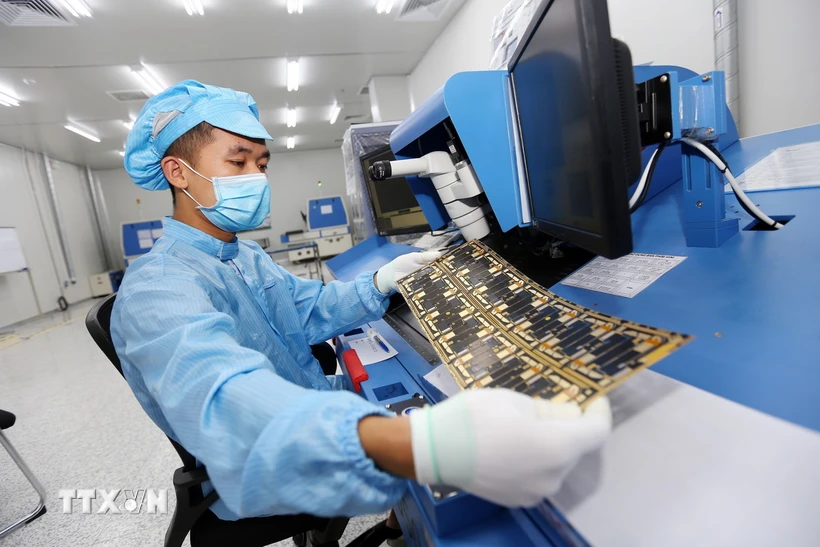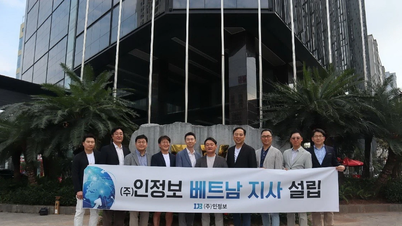According to Savills Vietnam, with its strategic location, large workforce and expanding infrastructure, Vietnam's industrial sector is poised for continued growth.

Vietnam's industrial and digital sectors are growing strongly, supported by strong foreign direct investment (FDI) inflows, large-scale infrastructure projects and a favorable regulatory environment.
The shift towards high value-added manufacturing coupled with expanding logistics and data center capabilities are boosting Vietnam’s position in the global supply chain.
These comments were made in the report "Vietnam Industry Focus 2024: New Wave" published by Savills Vietnam on November 8.
According to Savills Vietnam, the success of Vietnam's industrial sector is underpinned by a number of factors, including a dynamic workforce, preferential government policies, openness to trade, a strategic location, and continuous upgrading and improvement of infrastructure. High-value industries such as electronics and semiconductors are driving growth, shaping real estate demand and attracting regional investment.
“Vietnam has transformed from a traditional manufacturing base with companies focused on finding lower labor costs, to a more high-tech, specialised country with high manufacturing capacity,” said Troy Griffiths, Deputy Director of Savills Vietnam.
With its competitive costs, strategic location and participation in numerous trade agreements, Vietnam is well positioned to capture this new wave of investment. As it integrates into global markets, Vietnam will play a key role in the future of Southeast Asia’s industry, maintaining its reputation as an ideal destination for industrial and logistics solutions.
In attracting FDI capital to Vietnam, high-value industries such as electronics, auto components, semiconductors and green technology are leading. Savills Vietnam said that key investing countries including South Korea, Singapore and Japan have highlighted the trend of shifting to high-tech, high-value manufacturing, accounting for about 63% of FDI capital, far surpassing the traditional low-cost manufacturing sector.
To consolidate the new wave of investment, Vietnam is boosting investment in infrastructure, spending 7% of GDP on key projects such as the North-South Expressway, Long Thanh International Airport and deep-water ports such as Cai Mep in Ba Ria-Vung Tau..., creating direct connections with Europe, America and Southeast Asia.

The Northern Key Economic Region benefits from strong infrastructure, including highways and major ports such as Hai Phong and Lach Huyen, enhancing its attractiveness for export industries.
The extensive port system of the Southern Key Economic Zone, especially the deep-water port of Cai Mep, enables direct shipping to international markets and reinforces Vietnam's role as a key logistics hub.
In addition to transport infrastructure, Vietnam is also boosting digital connectivity with the expansion of 5G networks and the development of data centers, supporting the growth of e-commerce and logistics.
Mr. John Campbell, Director-Head of Industrial Real Estate at Savills Vietnam, emphasized that strong FDI inflows, strategic location, competitive costs, e-commerce growth, open trade policies and Vietnam's role in the global supply chain will be essential for the long-term supply and performance of the warehouse segment.
Going into specific analysis of investment attraction advantages, Savills Vietnam experts emphasized that with the development of the e-commerce industry and increased FDI, the demand for warehouses and ready-built industrial premises has increased sharply.
In 2024, ready-built (RB) factory and warehouse supply will increase by 31%, with occupancy rates exceeding 80% in key areas. Typically, the Southern region, with its logistics advantages, is favored due to its competitive costs and strategic location, serving both domestic and international customers.
“Warehouse costs in Vietnam remain attractive, averaging US$5.6 per square meter, attracting companies adopting a ‘China +1’ strategy. Developers are tapping into this strong demand with modern, high-tech facilities, including environmentally friendly options that meet international standards,” the Savills Vietnam report highlighted.

At the same time, the Government's support for logistics development through investment in diverse forms of transport and specialized logistics zones helps promote growth, positioning Vietnam as a priority location for efficient and cost-effective industrial solutions.
“Strong manufacturing exports have played a key role in Vietnam’s economic recovery this year. FDI inflows into value-added manufacturing have significantly boosted the country’s overall export growth, with electronics emerging as a major contributor,” said John Campbell.
As the digital economy sweeps across Asia, Vietnam is emerging as a key market for data centers. Valued at $685 million in 2023, the Vietnamese data center market is expected to reach $1.4 billion by 2029, driven by rising demand for cloud computing, 5G, and IoT. The Vietnamese government’s Digital Transformation Program aims for 50% of businesses to operate digitally by 2025, underscoring Vietnam’s commitment to becoming a digital hub.
Regulatory changes are encouraging foreign investment in data centers by allowing them to fully own domestic data centers. Companies such as ST Telemedia have partnered with local companies to expand new facilities in Ho Chi Minh City. Vietnam’s high internet penetration and booming e-commerce sector are also driving demand for investment in the sector, positioning data centers as a key pillar in the country’s economic future.
In 2024, e-commerce revenue in Vietnam increased by 38%, led by platforms such as Shopee and TikTok shop. The expansion of online retail also fueled the need for warehousing, logistics and data storage, cementing Vietnam’s role as a fast-growing digital economy in Southeast Asia.
Savills Vietnam's report also stated that with its strategic location, large workforce and expanding infrastructure, Vietnam's industry is poised for continued growth.
In 2025, high-value industries and FDI are expected to continue to drive steady demand for industrial real estate thanks to focused investment policies, a series of strong infrastructure projects and the ongoing shift in global manufacturing (China +1 strategy).
Along with that, Vietnam's commitment to public investment and extensive system of trade agreements will continue to strengthen its competitive advantage and position Vietnam as a focal point in the regional supply chain./.



































![[Photo] General Secretary To Lam begins official visit to Russia and attends the 80th Anniversary of Victory over Fascism](https://vphoto.vietnam.vn/thumb/1200x675/vietnam/resource/IMAGE/2025/5/8/5d2566d7f67d4a1e9b88bc677831ec9d)
![[Photo] Prime Minister Pham Minh Chinh meets with the Policy Advisory Council on Private Economic Development](https://vphoto.vietnam.vn/thumb/1200x675/vietnam/resource/IMAGE/2025/5/8/387da60b85cc489ab2aed8442fc3b14a)



























































Comment (0)